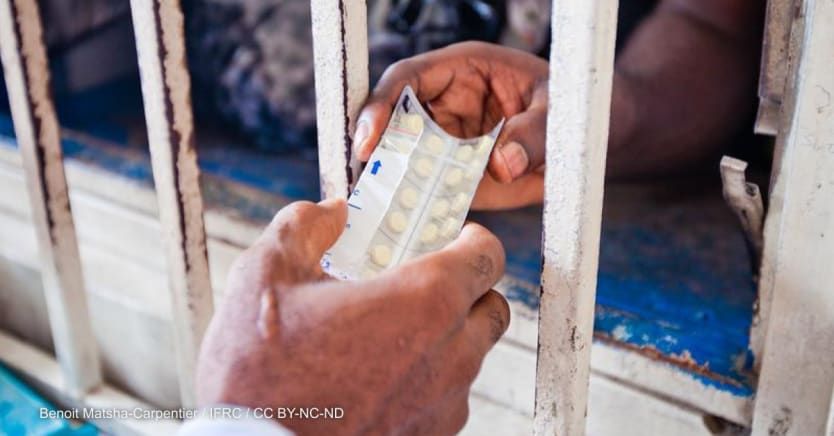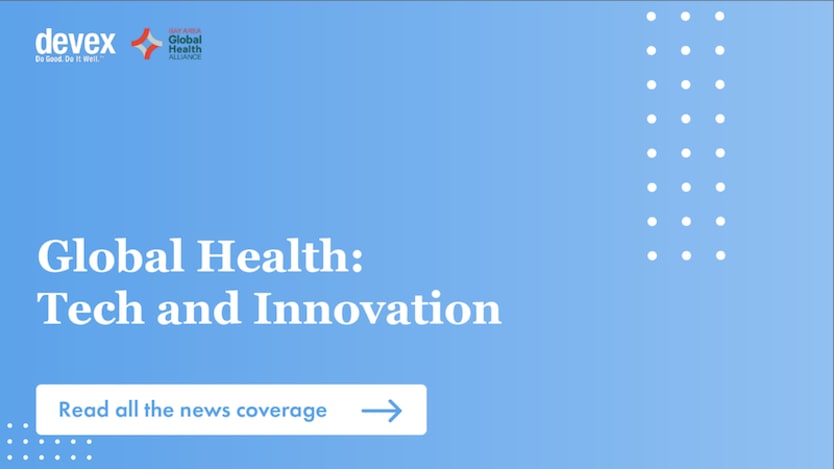
Running out of stock of essential health products is a critical issue in low- and middle-income countries. But all too often, decision-makers estimate demand solely by looking back on recent months instead of using advanced forecasting models, which draw on a wide variety of data sources to make predictions for the future.
The COVID-19 pandemic has highlighted the need for advanced analytics to improve demand forecasting in health care supply chains, whether for coronavirus vaccines or the many essential health products and services disrupted by the pandemic.
Macro-Eyes, an artificial intelligence company focused on making supply chains proactive instead of reactive, was recently selected as the winner of the U.S. Agency for International Development’s Intelligent Forecasting Field Implementation Grant.
Its STRIATA product, which uses machine learning “to forecast supply and demand at scale when conventional data is limited and uncertainty is the constant,” rose to the top of a global competition with 100 participating organizations working to model contraceptive needs in Côte d’Ivoire.
The grant highlights the use of supply chain forecasting to ensure the right health products and quantities are in stock, thereby reducing stockouts, product expiration, and costs.
Supply chain forecasting is a clear example of how artificial intelligence and machine learning can make health care more predictive, said Benjamin Thelonious Fels, the founder and CEO at Macro-Eyes.
“Forecasts drive any industry that has to send things to different points on the map. Health clinics, the government, and companies that sell contraceptives generate forecasts about what is going to be used where. All we’re doing is improving on how those forecasts are generated,” he said.
“While forecasting and use of new data science is important for all health products, nowhere does it become more important than in sexual reproductive health and contraceptives.”
— Prashant Yadav, senior fellow, Center for Global DevelopmentWith support from the Bill & Melinda Gates Foundation and others, Macro-Eyes has built predictive supply chains for vaccines in several countries, including Tanzania, where it combines electronic immunization registries, satellite imagery, publicly available data, and communication with health workers to anticipate shifts in demand at the health facility level.
Macro-Eyes has partnered with USAID, the U.S. Defense Department, and the Gates Foundation, which has provided the company with several grants, including one for creating an algorithm to automate the inventory counting process for family planning commodities.
That work, which began in 2019, informed more recent efforts using STRIATA to model contraceptive needs.
The Macro-Eyes CEO said intelligent forecasting, whether for contraceptives, vaccines, or other essential health products, is the perfect use of machine learning in global health.
“We can get to meaningful results without going through a painful process of disruption,” he said. “It’s something that’s already happening. We’re just delivering a higher-quality version of it.”
STRIATA is not replacing a person with a machine but instead processing huge amounts of data to inform human decisions about how to make the best use of scarce resources.
While Macro-Eyes has demonstrated how its technology can help build predictive supply chains for vaccines, the question now is whether the company can apply some of the same techniques to sexual and reproductive health.
Access to contraceptives is vital for women to choose the number, timing, and spacing of their pregnancies.
“While forecasting and use of new data science is important for all health products, nowhere does it become more important than in sexual reproductive health and contraceptives,” said Prashant Yadav, a senior fellow at the Center for Global Development who is also on the board at Macro-Eyes, during a November event on improving global health forecasting.
“Having a full choice of products present at the clinic is extremely important for achieving program outcomes, and having a choice requires putting more effort in understanding what is the demand for each particular method at the clinic,” Yadav said.
But generating the data for this kind of forecasting will not be easy. With 47% of women paying out of pocket for contraceptives, much of the data critical to predictive forecasting in sexual and reproductive health sits with users, outside the public domain.
“There is that inherent complexity to SRH,” said Natasha Sunderji, global health lead at Accenture, which advises donors, NGOs, multilateral agencies, and others on digital health. “It creates this fragmented view of what’s actually happening in the market.”
Opinion: How to close the contraception gap for women in crisis settings
It is critical that humanitarian organizations double down on holding all donor governments accountable for their global commitments to women’s sexual and reproductive health and rights.
SEMA Reproductive Health, a new donor-supported partnership that is focused on access to sexual and reproductive health products, is one example of an effort to build a more comprehensive view of supply and demand for contraceptives across regions and sectors, which will support better forecasting.
Macro-Eyes is collaborating with Côte d’Ivoire-based data entrepreneur Michael Konan and experts in supply chain forecasting from the University of Novi Sad in Serbia for the Intelligent Forecasting Field Implementation Grant.
Konan, who connected with the Macro-Eyes team at a virtual event hosted by USAID, told Devex he is concerned that data quality issues — such as missing or inconsistent values, as well as typing errors — could pose a challenge to the project.
“Garbage in, garbage out,” he said in an email.
But Konan said these efforts with contraceptives could open the door for predictive supply chain work involving other essential medicines in Côte d'Ivoire and beyond.
During the November event on global health forecasting, Nancy Lowenthal, country representative for USAID in Côte d’Ivoire, applauded the nation for being a “pioneer,” saying the intelligent forecasting of contraceptives could benefit other places around the world as well.
USAID confirmed that if the implementation is successful, the approach may be expanded to support the entire national health system or even public health supply chains in other countries.
“USAID will continue to analyze and learn from the various models submitted to the prize competition, to assess what works well in those models and how we can use those learnings to continue to improve forecasting for contraceptives and other essential health supplies,” a USAID spokesperson told Devex.
This coverage, presented by the Bay Area Global Health Alliance, explores the intersection between technology, innovation, and health. How are tech, innovation, and cross-sector partnerships being leveraged to accelerate equitable access to health care?









